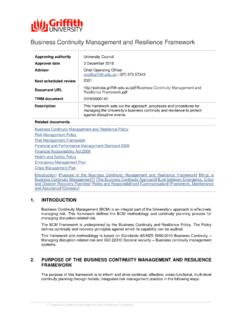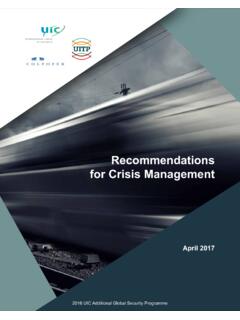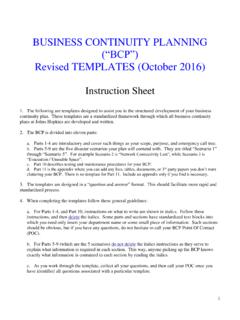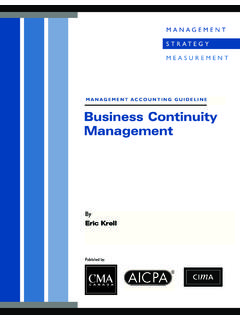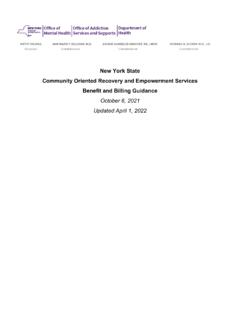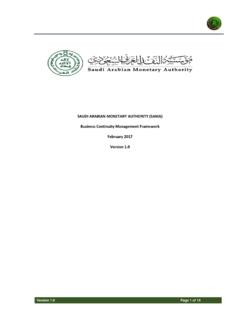Transcription of Essential Steps for Crisis Management and Crisis …
1 W o r d c o u n t : 3 , 0 3 2 4 / 2 1 / 2 0 1 5 Andromachi Ioannou 126109 IB X3215 Dr. Andreas Andrianopoulos Essential Steps for Crisis Management and Crisis Containment 2 Introduction While international business expansion undoubtedly presents many opportunities, there are also a multitude of challenges that companies face when deciding to operate on a global scale. This is because today s international business environment is largely uncontrollable, highly uncertain and complex and constantly evolving, which exposes companies to multiple areas of risk.
2 As a consequence, no organization, regardless of its size or strength is immune from a Crisis that can strike unexpectedly, and that can have profound negative effects on its operations, can imperil future growth, profitability, and even the company s survival. Managers must recognize the necessity to develop the skills to handle any threat and challenge that will inevitably arise, and make it a priority to be ready to handle such a Crisis , through careful and meticulous preparation. A Crisis is any situation or series of events that launch a group, team or an organization into a downward spiral, by threatening to harm people or property and negatively impact and damage an organization, its stakeholders, or even an entire industry if not handled effectively and efficiently, characterized by high consequence, low probability, ambiguity, and decision-making time pressure, (J.)
3 Hale, Dulek, and D. Hale, 2005), and always creates three inter related threats: public safety, financial loss due to disruption of operations and loss of market share, and inevitably reputation damage, because it reflects poorly on an organization (Coombs, 2011). Taneja , et al (2014) explain that according to Mitroff, crises can be divided in seven major families: economic which includes events or situations such as strikes, market crashes, and shortage of labor opportunities, informational, where there is a loss of important information or organizational records, public or confidential, theft through phishing attacks or social engineering or leaking of sensitive data, physical, which includes compromised major equipment, loss of suppliers or a major disruption at a key operating plant, human resources, could be the loss of a key executive or member of the team, vandalism.
4 Or workplace violence, reputational such as rumors and gossip which can hurt the reputation of the organization. The sixth family includes, psychopathic acts, , unthinkable acts such as terrorist attacks, kidnapping or even tampering with products, and finally natural disasters, includes tornadoes, earthquakes, fire and flash floods, or outbreak of a disease Companies must consider and prepare for each one, because by omitting any they potentially make their organizations vulnerable, through effective Crisis Management which can be divided into three phases.
5 The pre- Crisis phase, in which the company will aim to prevent and prepare for a Crisis , the Crisis response phase, when the Management will actually deal with the Crisis , try to contain it and limit its damages, and the post- Crisis phase, concerned with the long term goal of recovery from damage and image restoration (Coombs, 2011). 3 Pre- Crisis phase The pre- Crisis phase aims to prevent crises through risk assessment, which is (..) the process of identification, analysis and response to the project risks (..) (Petru, 2013), and consists of scanning and analyzing the environment in order to systematically identify, assess, quantify risks by amount of importance, and prioritize the respective environmental risks to the business, estimate the probability of a particular Crisis occurring, its expected frequency and its potential impact on operations.
6 Geo-political risks that can affect companies are political instability, geo-political conflict, regime changes, corruption, attitude towards foreign investors and governance risk, which is the ability to exercise effective control over an MNE s operations within a country s legal and political environment, (Political Risk Assessment and Management , 2005.), because conflicts may arise between the company s objectives and those of the host governments, (such as the firm s impact on economic development). Economic risks may include monetary and fiscal policies, fiscal sustainability, levels of government debt and deficit and interest rate shocks at the macro-economic level, and income distribution at the micro-economic level.
7 Legal risks may include legislative changes and discriminatory government regulations. Social factors that can cause a Crisis are social unrest such as riots and strikes and cultural differences. Environmental factors have to do with a country s climate and geo-political location which can cause natural disasters in extreme situations. Risks at the global level are associated with the country s economic associations, intergovernmental relations, terrorism and war, anti-globalization movement, environmental concerns, poverty, or cyberattacks.
8 (Schaechter, 2013) These risks can be assessed by using professional risk analysts who create firm-specific reports by relating risk attributes of specific countries to the particular characteristics and vulnerabilities of their client firms. Research should take into account that different companies may have very different degrees of vulnerability to risk and be affected differently. (Political Risk Assessment and Management , 2005) Data can be collected from local media, diplomatic sources, outstanding expert consultants, or other business persons who have had recent experience in the host country, or even on-site visits.
9 In order to asses a country s risk level, companies may look for evidence of present turmoil or dissatisfaction, indications of economic stability, and trends in cultural and religious activities. Stakeholders must also be involved in the Management of crises, by being made aware of identified potential risks through risk communication , which includes conveying ongoing Crisis events to stakeholders, decision making within the Crisis Management team, and organizational decisions regarding whether and what amount of information to share.
10 (J. Hale, Dulek, and D. Hale, 2005), in order to keep their stakeholders and employees informed and prepared to act in case of a Crisis . (Taneja et al. 2014). When risks include public safety, local authorities and emergency services should also be informed, so that they can prepare and develop emergency plans. When operating in a multinational setting, these communication strategies must be account for language barriers, different communication channels, and cultural experiences which can differ from country to country. According to Fatima Oliveira, (2013), organizations must have a polycentric approach and be proactively educational, possibly enlisting local help of specialists who know the public relations culture of the country.



